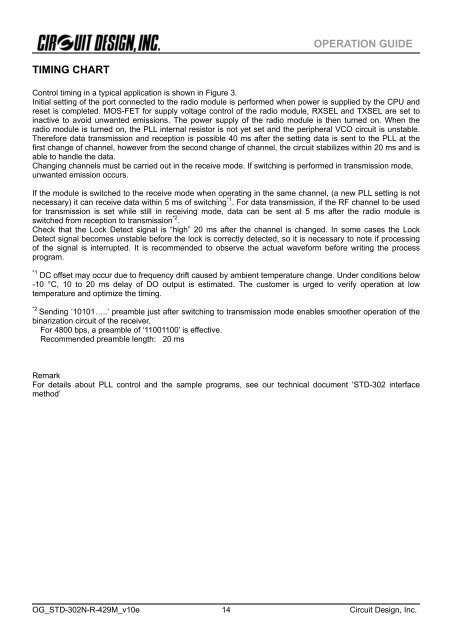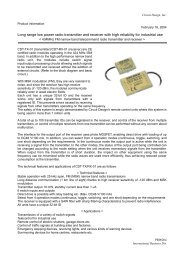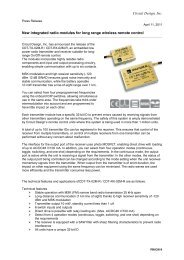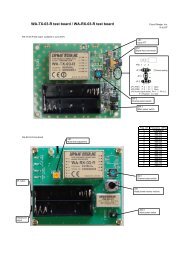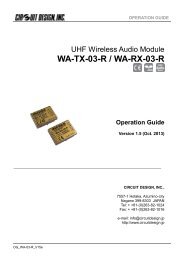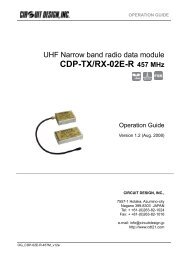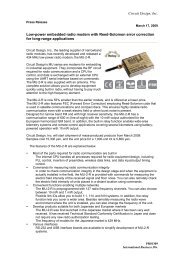STD-302N-R 429MHz Operation Guide - Circuit Design, Inc.
STD-302N-R 429MHz Operation Guide - Circuit Design, Inc.
STD-302N-R 429MHz Operation Guide - Circuit Design, Inc.
You also want an ePaper? Increase the reach of your titles
YUMPU automatically turns print PDFs into web optimized ePapers that Google loves.
OPERATION GUIDE<br />
TIMING CHART<br />
Control timing in a typical application is shown in Figure 3.<br />
Initial setting of the port connected to the radio module is performed when power is supplied by the CPU and<br />
reset is completed. MOS-FET for supply voltage control of the radio module, RXSEL and TXSEL are set to<br />
inactive to avoid unwanted emissions. The power supply of the radio module is then turned on. When the<br />
radio module is turned on, the PLL internal resistor is not yet set and the peripheral VCO circuit is unstable.<br />
Therefore data transmission and reception is possible 40 ms after the setting data is sent to the PLL at the<br />
first change of channel, however from the second change of channel, the circuit stabilizes within 20 ms and is<br />
able to handle the data.<br />
Changing channels must be carried out in the receive mode. If switching is performed in transmission mode,<br />
unwanted emission occurs.<br />
If the module is switched to the receive mode when operating in the same channel, (a new PLL setting is not<br />
necessary) it can receive data within 5 ms of switching *1 . For data transmission, if the RF channel to be used<br />
for transmission is set while still in receiving mode, data can be sent at 5 ms after the radio module is<br />
switched from reception to transmission *2 .<br />
Check that the Lock Detect signal is “high” 20 ms after the channel is changed. In some cases the Lock<br />
Detect signal becomes unstable before the lock is correctly detected, so it is necessary to note if processing<br />
of the signal is interrupted. It is recommended to observe the actual waveform before writing the process<br />
program.<br />
*1 DC offset may occur due to frequency drift caused by ambient temperature change. Under conditions below<br />
-10 °C, 10 to 20 ms delay of DO output is estimated. The customer is urged to verify operation at low<br />
temperature and optimize the timing.<br />
*2<br />
Sending ‘10101…..’ preamble just after switching to transmission mode enables smoother operation of the<br />
binarization circuit of the receiver.<br />
For 4800 bps, a preamble of ‘11001100’ is effective.<br />
Recommended preamble length: 20 ms<br />
Remark<br />
For details about PLL control and the sample programs, see our technical document ‘<strong>STD</strong>-302 interface<br />
method’<br />
OG_<strong>STD</strong>-<strong>302N</strong>-R-429M_v10e<br />
14<br />
<strong>Circuit</strong> <strong>Design</strong>, <strong>Inc</strong>.


